Unlock the Potential of AI-Driven Marketing with VORTIX AI, Redefining Possibilities, Amplifying Success. Explore the possibilities and unlock your business’s full potential. Join us on this journey to redefine the future of marketing!
Don't wanna be here? Send us removal request.
Text
Digital marketing is crucial for e-commerce businesses in 2025
Digital marketing is crucial for e-commerce businesses in 2025 because it drives online visibility, customer engagement, and revenue growth in an increasingly competitive and digital-first world. Here are some key reasons why it’s more important than ever:

1. Increased Online Shopping Trends
Consumers are relying more on online shopping due to convenience and a broader range of products.
Global e-commerce sales are projected to keep growing, making digital marketing essential for reaching new audiences.
2. Personalized Customer Experiences
Digital marketing allows businesses to offer personalized experiences using data analytics, AI, and machine learning.
Customized product recommendations, targeted promotions, and personalized emails enhance customer satisfaction and loyalty.
3. Omnichannel Marketing
Consumers engage with brands across multiple touchpoints—websites, social media, email, and mobile apps.
An effective digital marketing strategy ensures a seamless and consistent experience across all platforms, increasing customer retention.
4. SEO and Search Visibility
With millions of e-commerce sites competing, optimizing for search engines is vital for visibility.
Effective SEO strategies improve organic traffic, which reduces reliance on paid ads while enhancing long-term growth.
5. Social Media Influence
Social commerce (shopping directly on social media platforms) is growing rapidly.
Platforms like Instagram, TikTok, and Facebook allow businesses to showcase products, engage with customers, and drive direct sales.
6. Data-Driven Decision Making
Digital marketing tools provide real-time insights into customer behavior, sales patterns, and campaign performance.
E-commerce businesses can use this data to optimize strategies, improve ROI, and predict future trends.

7. Cost-Effective Advertising
Digital marketing offers cost-effective advertising methods like pay-per-click (PPC), influencer marketing, and retargeting.
Compared to traditional advertising, these strategies provide better targeting, performance tracking, and flexibility.
8. Enhanced Customer Engagement
Email marketing, chatbots, and personalized content keep customers engaged before and after purchase.
Strong engagement fosters customer loyalty and increases the likelihood of repeat purchases.
9. Global Reach
Digital marketing breaks geographical barriers, allowing e-commerce businesses to reach international customers.
With the right strategy, even small businesses can scale globally without significant infrastructure investments.
10. Staying Competitive
As technology evolves, competitors are investing in advanced digital marketing tactics.
To remain competitive, e-commerce businesses must adopt innovative marketing approaches such as voice search optimization, video marketing, and AI-driven campaigns.
TO READ MORE ARTICLES VISIT : https://vortixai.com/blog/
0 notes
Text
Social Commerce Innovations: The Future of Online Shopping
In the fast-evolving world of digital marketing, social commerce has emerged as a game-changer, blending social media engagement with seamless online shopping experiences. As brands and retailers adapt to new consumer behaviors, innovative social commerce trends are reshaping the e-commerce landscape. Here are some of the latest innovations driving the future of social commerce.

1. Shoppable Posts and Stories
Social media platforms like Instagram, Facebook, and Pinterest have integrated direct shopping features, allowing users to purchase products without leaving the app. Shoppable posts and stories enable businesses to tag products in images and videos, streamlining the customer journey from discovery to checkout.
2. Live Shopping Events
Live shopping combines entertainment with e-commerce, providing real-time interaction between brands and consumers. Platforms like TikTok, YouTube, and Facebook Live offer live-streamed shopping events where influencers and brands showcase products, answer questions, and drive instant purchases.
3. Augmented Reality (AR) Shopping
AR technology is revolutionizing the way consumers shop by offering virtual try-ons for products like clothing, accessories, and makeup. Brands like Sephora and IKEA have successfully integrated AR features, enhancing user engagement and reducing return rates.
4. AI-Powered Chatbots and Virtual Assistants
AI-driven chatbots are improving the online shopping experience by providing personalized recommendations, answering queries, and assisting with transactions. These smart assistants enhance customer service and create a more efficient purchasing process.
5. Social Media Marketplaces
Dedicated marketplaces on social platforms, such as Facebook Marketplace and Instagram Shops, have made it easier for businesses to reach a broader audience. These platforms offer a streamlined shopping experience with integrated payment options, making transactions more convenient.
6. Influencer and Micro-Influencer Collaborations
Influencer marketing continues to drive social commerce, with brands leveraging content creators to promote products authentically. Micro-influencers, who have niche audiences, are becoming increasingly valuable due to their high engagement rates and credibility among followers.

7. User-Generated Content (UGC) for Authentic Marketing
Consumers trust peer recommendations over traditional advertisements. Brands encourage users to share reviews, testimonials, and real-life product experiences through social media, creating a community-driven shopping experience.
8. Seamless Payment Integrations
One-click checkout and digital wallets, such as Apple Pay and Google Pay, simplify the buying process, reducing cart abandonment rates. Social commerce platforms integrate these payment solutions to enhance convenience and security.
9. Subscription-Based Social Shopping
Some brands are exploring subscription-based models within social commerce, offering exclusive deals, early access, and personalized recommendations to loyal customers. This approach fosters brand loyalty and long-term customer relationships.
10. Blockchain and NFT Integration
Blockchain technology is making its way into social commerce, ensuring secure transactions and authenticity of high-value digital assets. Some brands are leveraging NFTs (Non-Fungible Tokens) for unique digital ownership experiences tied to their products.
Social commerce innovations are revolutionizing the e-commerce landscape by merging social media engagement with seamless shopping experiences. As platforms continue to introduce new features, brands that leverage these trends effectively will thrive in the competitive digital marketplace. By embracing these innovations, businesses can build stronger connections with consumers and drive sales like never before.
For More such articles visit : www.vortixai.com\blog
0 notes
Text
Email Marketing in 2025: How to Beat the Spam Folder
Email marketing continues to be a powerful tool for businesses, but with increasing spam filters and stricter regulations, ensuring that your emails actually reach inboxes is more challenging than ever. As we step into 2025, marketers must adapt their strategies to bypass spam filters and maintain high email deliverability rates. Here’s how you can beat the spam folder and maximize your email marketing success.
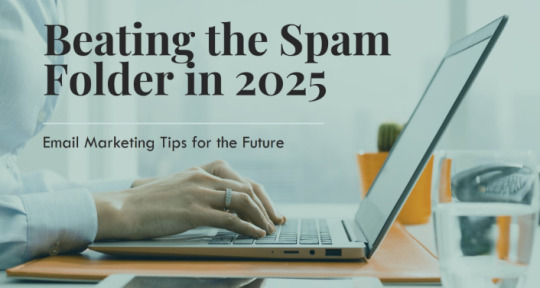
1. Understand How Spam Filters Work
Spam filters have become smarter, leveraging AI and machine learning to analyze email content, sender reputation, and user engagement. Emails that look promotional, contain spammy words (like "free money" or "urgent action required"), or have low engagement rates are more likely to land in spam. Understanding these factors helps in crafting emails that are inbox-friendly.
2. Authenticate Your Emails
Email authentication protocols help ISPs verify that your emails are legitimate. Make sure to implement the following:
SPF (Sender Policy Framework): Ensures emails come from an authorized server.
DKIM (DomainKeys Identified Mail): Adds a digital signature for authenticity.
DMARC (Domain-based Message Authentication, Reporting, and Conformance): Prevents email spoofing and phishing attacks.
These authentication methods improve deliverability and reduce the risk of your emails being flagged as spam.
3. Build and Maintain a Healthy Email List
A well-maintained email list improves deliverability and engagement. Here’s how to keep your list clean:
Use double opt-in to confirm subscribers genuinely want your emails.
Regularly remove inactive subscribers to maintain a high engagement rate.
Avoid purchasing email lists, as they often contain unverified or uninterested users.
4. Personalize and Segment Your Emails
Generic, one-size-fits-all emails are more likely to be ignored or marked as spam. Instead, use personalization and segmentation to increase engagement:
Address recipients by name and tailor content based on their behavior.
Segment your list by demographics, purchase history, or past interactions.
Use dynamic content to ensure emails are relevant and engaging.

5. Optimize Subject Lines and Content
Your subject line plays a crucial role in whether your email is opened or sent to spam. Follow these best practices:
Keep it short (under 50 characters) and to the point.
Avoid all caps, excessive punctuation, and spam-trigger words.
Use curiosity-driven or benefit-focused messaging.
Also, ensure your email content:
Has a good balance of text and images (too many images can trigger spam filters).
Includes a clear call to action (CTA) without being overly promotional.
Provides value rather than just selling.
6. Encourage Engagement
High engagement rates signal to email providers that your emails are wanted. Encourage recipients to:
Reply to your emails (this boosts your sender reputation).
Whitelist your email address (ask subscribers to add you to their contacts).
Click on links and interact with your content.
7. Test and Monitor Your Emails
Before sending, always test your emails to ensure they pass spam filters. Use tools like:
Mail Tester to check spam scores.
GlockApps or Litmus for deliverability testing.
Google Postmaster Tools to monitor your sender reputation.
Regularly track open rates, bounce rates, and spam complaints to adjust your strategy accordingly.
8. Comply with Email Regulations
Regulatory compliance is crucial in 2025. Ensure you adhere to:
CAN-SPAM Act (U.S.) – Includes requirements for opt-outs and sender information.
GDPR (Europe) – Requires explicit consent for sending emails.
CASL (Canada) – Enforces strict permission-based email marketing.
Always include an easy-to-find unsubscribe link and respect users’ privacy preferences.

Email marketing in 2025 requires a strategic approach to avoid spam filters and maintain high deliverability. By authenticating emails, maintaining a clean list, personalizing content, optimizing subject lines, and encouraging engagement, you can ensure your emails reach inboxes and drive results. Stay updated on best practices, monitor performance, and continuously refine your strategy for ongoing success.
Want to take your email marketing to the next level? Start implementing these strategies today and watch your open rates soar!
0 notes
Text
AI & Web Development: Transforming the Digital Landscape
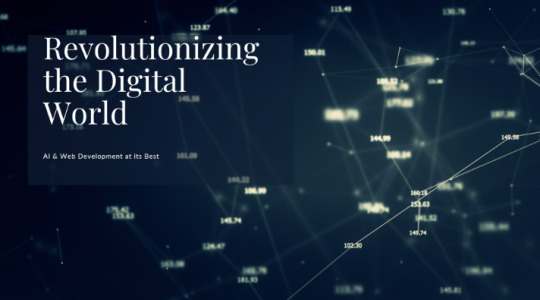
Artificial Intelligence (AI) is revolutionizing various industries, and web development is no exception. From enhancing user experience to automating processes, AI is changing the way websites and applications are built, maintained, and optimized. In this blog, we’ll explore how AI is shaping web development and what it means for developers and businesses alike.
How AI is Impacting Web Development
1. AI-Powered Website Builders
AI-driven website builders like Wix ADI and Bookmark’s AiDA allow users to create stunning websites without coding knowledge. These platforms analyze user preferences, industry trends, and content structure to generate customized web pages in minutes.
2. Enhanced User Experience with AI
AI improves user experience through:
Chatbots & Virtual Assistants – AI-powered chatbots like ChatGPT, Dialogflow, and IBM Watson provide instant responses and personalized assistance.
Personalized Content Recommendations – AI-driven recommendation engines suggest relevant content, products, or services based on user behavior and preferences.
Voice Search Optimization – AI enhances voice search capabilities, making websites more accessible for users relying on smart assistants like Alexa, Google Assistant, and Siri.
3. Automated Code Generation
AI-assisted development tools like GitHub Copilot and OpenAI Codex help developers write efficient code by suggesting relevant snippets, detecting errors, and even generating entire functions. This speeds up development time and reduces manual effort.
4. AI for Web Security
Cybersecurity threats are increasing, and AI helps mitigate risks through:
Anomaly Detection – AI algorithms identify and block unusual activities, preventing cyberattacks.
Automated Threat Analysis – AI-powered security tools scan websites for vulnerabilities and recommend fixes.
Fraud Detection – AI enhances security by detecting fraudulent transactions and unauthorized access attempts.
5. SEO & Content Optimization
AI-driven SEO tools like SEMrush, Surfer SEO, and Clearscope analyze search engine trends, optimize content, and improve ranking strategies. AI also helps in:
Keyword Research & Analysis
Content Generation & Summarization
Automated Meta Tagging & Image Optimization
6. AI-Powered Web Design
AI assists designers by:
Generating UI Components – Tools like Uizard and Adobe Sensei automate the design of web interfaces.
Analyzing Design Trends – AI studies user behavior to suggest optimal UI/UX designs.
Improving Accessibility – AI helps create accessible websites by optimizing contrast, font size, and navigation.



Challenges & Considerations
While AI offers numerous benefits, developers must be aware of potential challenges:
Data Privacy Concerns – AI requires large amounts of data, raising privacy and security issues.
Ethical Implications – AI-generated content must be monitored for biases and misinformation.
Limited Creativity – AI can assist in design and coding but lacks human intuition and creativity.
Future of AI in Web Development
As AI continues to evolve, we can expect more advancements, such as:
Fully Automated Web Development – AI could create and maintain websites with minimal human intervention.
AI-Generated Voice & Visual Interfaces – Enhancing user engagement with voice-controlled and immersive experiences.
Advanced Predictive Analytics – AI will help businesses predict user behavior and tailor web experiences accordingly.

AI is transforming web development by making it more efficient, secure, and user-friendly. While challenges exist, the benefits outweigh the drawbacks, making AI an essential tool for modern web development. By embracing AI, businesses and developers can stay ahead of the competition and deliver cutting-edge digital experiences.
Are you ready to integrate AI into your web development strategy? Let us know your thoughts in the comments!
0 notes
Text
Blockchain Integration in Web Development to Enhance Security
In today’s digital landscape, security is one of the biggest concerns for businesses and developers alike. As cyber threats continue to evolve, traditional security measures are no longer sufficient. This is where blockchain integration in web development emerges as a game-changer, offering enhanced security, transparency, and trust in online transactions and data storage.

Understanding Blockchain Technology
Blockchain is a decentralized ledger system that records data across multiple nodes, ensuring transparency and security. Each transaction is stored in blocks that are cryptographically linked, making it nearly impossible to alter or tamper with the recorded information. This decentralized nature makes blockchain a robust solution for securing web applications.
How Blockchain Enhances Security in Web Development
1. Data Integrity and Immutability
One of the primary benefits of blockchain integration in web development is data integrity. Once information is stored on a blockchain, it cannot be modified or deleted. This immutability ensures that data remains authentic, protecting it from unauthorized alterations and fraud.
2. Secure Transactions and Payments
Blockchain technology facilitates secure financial transactions by eliminating the need for intermediaries. Smart contracts, which are self-executing contracts with pre-set conditions, ensure transactions are transparent and fraud-proof. This is particularly beneficial for e-commerce platforms and fintech applications.
3. Decentralized Identity Management
Traditional login systems rely on centralized databases, making them vulnerable to hacks and data breaches. Blockchain-based identity management allows users to have a decentralized identity (DID), reducing the risk of unauthorized access and improving authentication security.
4. Protection Against DDoS Attacks
Websites and online applications are often targeted by Distributed Denial-of-Service (DDoS) attacks, where hackers overwhelm servers with traffic. Blockchain’s decentralized architecture distributes data across multiple nodes, making it extremely difficult for attackers to compromise the entire network.
5. Transparent and Tamper-Proof Logging
Blockchain provides an unalterable record of all transactions and activities, ensuring accountability. This is especially useful for industries that require audit trails, such as healthcare, finance, and supply chain management.

Use Cases of Blockchain in Web Development
E-commerce Security: Secure transactions and fraud prevention using smart contracts.
Healthcare Data Protection: Secure patient records and ensure HIPAA compliance.
Decentralized Social Media: Prevent data censorship and ensure user data privacy.
Supply Chain Transparency: Track product movement in real-time, reducing fraud.
Voting Systems: Enhance transparency and prevent election fraud through immutable records.
Challenges of Blockchain Integration in Web Development
Despite its numerous benefits, blockchain integration faces some challenges, including:
Scalability Issues: Blockchain networks can sometimes have slow transaction processing times.
Complex Implementation: Integrating blockchain into existing web applications requires expertise.
Regulatory Compliance: Governments are still developing regulations around blockchain use.
Blockchain technology is revolutionizing web development by offering unmatched security, transparency, and trust. As more businesses and developers adopt this technology, we can expect a future where web applications are more resilient against cyber threats. While challenges exist, ongoing advancements in blockchain will continue to enhance web security and create a safer digital ecosystem.
0 notes
Text
Content Marketing vs. Paid Ads: Where Should You Invest?
In the fast-paced world of digital marketing, businesses often face the question: should you focus on content marketing or invest in paid advertising? Both strategies offer unique advantages, but the right choice depends on your business goals, budget, and audience. Let’s dive into the key differences, benefits, and considerations to help you make an informed decision.

What Is Content Marketing?
Content marketing involves creating and sharing valuable, relevant, and consistent content to attract and engage your target audience. This can include blog posts, videos, infographics, eBooks, podcasts, and more. The primary goal is to build trust and establish authority over time, ultimately driving organic traffic and customer loyalty.
Pros of Content Marketing:
Long-Term Benefits: Once published, high-quality content can continue to attract traffic and leads for months or even years.
Builds Authority and Trust: By consistently providing value, you position your brand as an industry expert.
Cost-Effective: While creating content requires time and resources, the ongoing returns can outweigh initial investments.
Supports SEO: Well-optimized content improves your search engine rankings, increasing visibility and organic traffic.
Cons of Content Marketing:
Time-Consuming: Developing high-quality content takes time and effort.
Delayed Results: Content marketing is a long-term strategy, so it may take months to see significant returns.
Consistency Required: Sporadic content production can weaken your efforts.
What Are Paid Ads?
Paid advertising involves paying platforms like Google, Facebook, or LinkedIn to promote your content, products, or services. This includes search engine ads, social media ads, display ads, and more. The goal is to drive traffic, leads, or sales quickly by targeting specific audiences.
Pros of Paid Ads:
Immediate Results: Paid campaigns can drive traffic and conversions as soon as they go live.
Precise Targeting: Platforms offer advanced targeting options based on demographics, interests, and behaviors.
Scalable: You can increase or decrease your budget based on performance and goals.
Enhanced Visibility: Ads help you reach audiences that might not find you organically.
Cons of Paid Ads:
Cost: Paid advertising can become expensive, especially in competitive industries.
Short-Term Impact: Once your campaign ends, so does the traffic and visibility.
Ad Fatigue: Overexposure to the same ads can reduce effectiveness over time.
Complexity: Effective ad campaigns require expertise in targeting, design, and optimization.
Content Marketing vs. Paid Ads: Key Differences
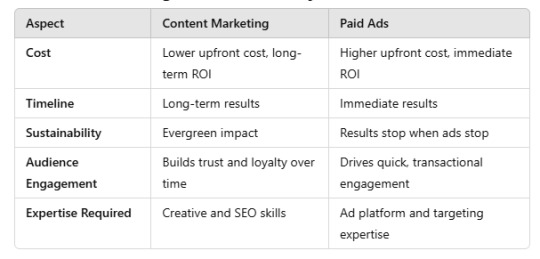
When to Choose Content Marketing
Long-Term Goals: If your aim is to build a sustainable online presence and establish authority, content marketing is the way to go.
Limited Budget: Content marketing offers long-term returns that don’t require constant investment.
SEO Strategy: If improving organic search rankings is a priority, invest in high-quality, optimized content.
Nurturing Relationships: For businesses that rely on trust and loyalty, content marketing helps foster deeper connections.
When to Choose Paid Ads
Immediate Results: If you need quick traffic, leads, or sales, paid ads are your best bet.
Launching a New Product or Service: Ads help generate buzz and visibility quickly.
Targeting Specific Audiences: For campaigns that need precise targeting, paid ads are highly effective.
Seasonal Promotions: Time-sensitive offers or events benefit from the instant visibility of ads.
Why Not Both?
The best digital marketing strategies often combine content marketing and paid ads. Here’s how:
Use Paid Ads to Amplify Content: Promote your best-performing content to reach a wider audience.
Leverage Content for Retargeting: Use engaging blog posts or videos in retargeting campaigns to nurture leads.
Balance Immediate and Long-Term Goals: Use paid ads for short-term results while building a strong content foundation for sustainable growth.

Choosing between content marketing and paid ads doesn’t have to be an either/or decision. Each strategy serves different purposes and can complement the other. By understanding your goals, budget, and audience, you can craft a balanced approach that maximizes your marketing ROI. Ready to make the most of your digital marketing efforts? Start by defining your priorities and experimenting with a mix of both strategies to see what works best for your business.
0 notes
Text
Data-Driven Marketing Strategies to Boost Your Online Sales in 2025

In the ever-evolving world of e-commerce, data-driven marketing continues to stand out as a game-changer. With consumers demanding personalized and seamless experiences, businesses that leverage data effectively can gain a significant competitive edge. Here’s a deep dive into how you can harness data-driven marketing strategies to elevate your online sales in 2025.
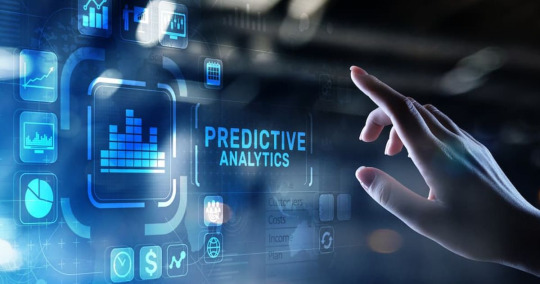
1. Personalized Customer Experiences
Personalization has become the cornerstone of successful digital marketing. By analyzing customer data—such as browsing behavior, purchase history, and demographics—you can create tailored experiences that resonate with your audience. In 2025, tools like AI-powered recommendation engines and dynamic website content are more accessible than ever. These tools help businesses deliver the right message to the right customer at the right time.
Example: Implementing personalized email campaigns that feature products based on a customer’s past purchases or abandoned carts can significantly boost conversion rates.
2. Predictive Analytics for Proactive Strategies
Predictive analytics uses historical data and machine learning algorithms to forecast future trends and customer behaviors. This allows businesses to anticipate customer needs and optimize their marketing strategies accordingly.
How to Use Predictive Analytics:
Identify products that are likely to trend in the near future.
Target customers who are most likely to make repeat purchases.
Optimize inventory based on forecasted demand.
By staying ahead of consumer trends, you can reduce waste, increase customer satisfaction, and boost sales.
3. Omni-Channel Integration
Today’s customers engage with brands across multiple platforms, from social media to email to in-store visits. A data-driven omni-channel strategy ensures consistency and seamless transitions between these touchpoints. By collecting and analyzing data from all channels, you can deliver a unified experience.
Best Practices for Omni-Channel Marketing:
Use a centralized customer data platform (CDP) to manage customer information.
Align messaging across all channels to ensure consistency.
Track customer journeys to identify touchpoints that drive conversions.
4. AI-Driven Ad Targeting
Paid advertising has become increasingly sophisticated with the integration of artificial intelligence. AI tools analyze vast amounts of data to identify high-performing audiences, optimize ad placements, and predict the best times to run campaigns.
Strategies to Implement:
Use AI tools like Google’s Performance Max or Meta’s Advantage+ campaigns to automate and enhance targeting.
Leverage lookalike audiences to expand your reach while maintaining relevance.
Continuously analyze ad performance data to refine campaigns in real-time.
5. Customer Segmentation for Precision Marketing
Segmentation involves dividing your audience into smaller, more manageable groups based on shared characteristics. Data-driven segmentation enables precision marketing, ensuring that your messages resonate deeply with each group.
Key Segmentation Criteria:
Demographics (age, gender, location)
Bavioral data (purchase history, website activity)
Psychographics (values, interests, lifestyle)
By tailoring your marketing efforts to each segment, you can increase engagement and drive conversions.
6. Leverage Social Listening
Social listening involves tracking conversations about your brand, competitors, and industry on social media platforms. This real-time data provides insights into customer sentiment, preferences, and emerging trends.
How to Utilize Social Listening:
Identify gaps in customer expectations and address them proactively.
Tailor your content strategy to reflect trending topics.
Monitor competitor activity to stay ahead of the curve.
7. Focus on First-Party Data
With increasing privacy regulations and the phase-out of third-party cookies, first-party data—information collected directly from your audience—is more valuable than ever. This data is not only more reliable but also aligns with consumer expectations for privacy.
Tips for Collecting First-Party Data:
Encourage customers to sign up for newsletters or loyalty programs.
Use interactive content like quizzes or polls to gather insights.
Implement feedback forms to understand customer preferences and pain points.
8. Invest in Real-Time Analytics
Real-time analytics enables businesses to monitor customer behavior as it happens. This allows for immediate adjustments to campaigns, inventory, and customer interactions.
Applications of Real-Time Analytics:
Offer dynamic pricing based on real-time demand.
Send personalized offers during live shopping events.
Optimize website performance to reduce cart abandonment rates.
As we step further into 2025, data-driven marketing is no longer optional—it’s a necessity. By leveraging advanced analytics, AI tools, and customer insights, businesses can create personalized, efficient, and impactful marketing strategies that drive online sales. Start integrating these strategies today to stay ahead in the competitive e-commerce landscape.
0 notes
Text
The Future of SaaS in 2025: Trends and Innovations
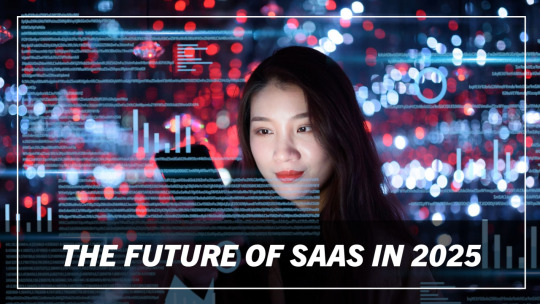
As we step into 2025, the Software as a Service (SaaS) industry continues to be at the forefront of technological innovation, redefining the way businesses operate and deliver value. With global SaaS revenues projected to exceed $200 billion, the sector is poised for unprecedented growth. Here, we explore the key trends and innovations shaping SaaS in 2025.
1. AI-Driven Automation and Personalization
Artificial intelligence (AI) has become the backbone of SaaS applications, enabling businesses to automate processes, derive insights, and offer personalized experiences at scale. In 2025, we’re seeing:
Hyper-Personalized User Experiences: SaaS platforms use AI to analyze user behavior, tailoring interfaces and recommendations to individual preferences.
Predictive Analytics: AI-powered tools predict customer needs, optimize workflows, and reduce churn.
Enhanced Customer Support: Chatbots and virtual assistants are now more conversational and capable, offering seamless 24/7 support.
2. Vertical SaaS Gains Momentum
While horizontal SaaS platforms cater to a wide range of industries, vertical SaaS solutions focus on niche markets with tailored functionalities. Examples include healthcare, fintech, and real estate SaaS products. By addressing industry-specific pain points, vertical SaaS providers are delivering unmatched value and fostering deeper customer loyalty.
3. Rise of No-Code and Low-Code Platforms
The democratization of software development continues to accelerate in 2025, with no-code and low-code platforms empowering non-technical users to build and customize applications. These tools enable businesses to:
Rapidly prototype and deploy solutions.
Reduce dependency on traditional development cycles.
Encourage innovation within teams without coding expertise.
4. Focus on Data Privacy and Compliance
With evolving regulations like GDPR, CCPA, and others worldwide, SaaS companies are doubling down on data security and compliance. Features such as built-in encryption, robust access controls, and transparent data handling practices are now standard. Companies that can prove their commitment to data privacy will continue to win trust and market share.

5. Hybrid and Remote Work Optimization
The post-pandemic era has solidified hybrid and remote work as a permanent fixture. SaaS tools designed to support distributed teams are thriving, with features like:
Advanced video conferencing with AI transcription and sentiment analysis.
Unified communication platforms integrating messaging, project management, and file sharing.
Enhanced collaboration tools tailored for asynchronous workflows.
6. Integration and Interoperability
Businesses are increasingly demanding SaaS solutions that integrate seamlessly with existing tech stacks. Open APIs, modular architectures, and partnerships between SaaS vendors are ensuring smoother data flow and interoperability across platforms, enabling businesses to:
Reduce silos and improve operational efficiency.
Leverage combined insights from multiple tools.
Scale solutions without significant disruptions.
7. Subscription Models Evolve
Subscription fatigue has pushed SaaS companies to innovate their pricing strategies. In 2025, we’re witnessing:
Usage-Based Pricing: Customers pay based on actual usage rather than flat fees.
Freemium Models: Offering robust free tiers with the option to unlock premium features.
Customizable Plans: Allowing customers to tailor plans based on specific needs.
8. Green SaaS and Sustainability Initiatives
Environmental consciousness is reshaping the SaaS industry, with companies striving to minimize their carbon footprints. Green SaaS involves:
Optimizing data center energy efficiency.
Partnering with renewable energy providers.
Offering transparency in sustainability efforts, which appeals to eco-conscious consumers.
9. Edge Computing Meets SaaS
As businesses demand faster processing and reduced latency, edge computing is becoming a critical component of SaaS architecture. By processing data closer to the source, SaaS applications can deliver:
Real-time insights.
Enhanced performance for IoT and mobile applications.
Improved reliability in regions with limited connectivity.
10. Global Expansion and Localization
SaaS companies are breaking barriers to enter emerging markets, where demand for cloud-based solutions is growing rapidly. Localization efforts include:
Multi-language support.
Compliance with local regulations.
Tailoring user experiences to cultural nuances.
The SaaS landscape in 2025 is dynamic, innovative, and customer-centric. By leveraging AI, prioritizing security, and embracing sustainable practices, SaaS companies are not only meeting current demands but also setting the stage for future growth. As businesses continue to adopt cloud-first strategies, the role of SaaS in driving digital transformation will only grow more significant.

0 notes
Text
How to Use AI to Supercharge Your Digital Marketing Strategy in 2025

Artificial Intelligence (AI) is transforming the digital marketing landscape, offering businesses unprecedented opportunities to personalize campaigns, optimize performance, and drive growth. As we step into 2025, AI is no longer a futuristic concept—it’s a game-changer for marketers ready to embrace its potential. In this blog, we’ll explore how you can leverage AI to enhance your digital marketing strategy and stay ahead of the competition.
1. Personalization at Scale
AI enables marketers to deliver highly personalized experiences to their audiences. By analyzing customer data, AI algorithms can identify patterns, preferences, and behaviors to create tailored content and offers. Here’s how you can use AI for personalization:
Dynamic Content Creation: Tools like ChatGPT can generate personalized emails, ad copy, and website content based on user preferences.
Product Recommendations: AI-driven recommendation engines, like those used by Amazon and Netflix, suggest products or content that align with a user’s interests.
Behavioral Targeting: AI can segment audiences based on real-time data, ensuring your campaigns reach the right people at the right time.
2. Enhanced Customer Insights
AI-powered analytics tools go beyond traditional data analysis by identifying trends and predicting future behaviors. These insights can guide your marketing strategy and optimize decision-making.
Predictive Analytics: Forecast customer needs and preferences to create proactive marketing campaigns.
Sentiment Analysis: Understand how customers feel about your brand by analyzing social media comments, reviews, and feedback.
Audience Segmentation: Use AI to segment your audience into granular groups for more effective targeting.
3. Automating Routine Tasks
Automation is one of AI’s greatest strengths, freeing up time for marketers to focus on strategy and creativity. Some ways AI can streamline your workflow include:
Chatbots: AI-powered chatbots provide instant customer support, answer FAQs, and guide users through your website.
Automated Ad Campaigns: Platforms like Google Ads use AI to optimize bidding, targeting, and ad placements.
Social Media Scheduling: Tools like Buffer and Hootsuite leverage AI to identify the best times to post and suggest relevant content.
4. Optimizing Content Marketing
AI tools can supercharge your content strategy by helping you create, optimize, and distribute content more effectively.
Content Ideation: Use AI to generate blog topics, headlines, and outlines based on trending keywords and audience interests.
SEO Optimization: AI tools like Surfer SEO and Clearscope analyze search engine algorithms to ensure your content ranks high.
Multimedia Content: AI-driven platforms can help you create visuals, videos, and interactive content tailored to your audience.

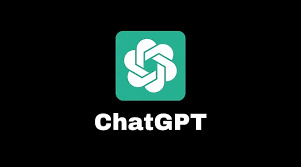
5. Revolutionizing Paid Advertising
AI is revolutionizing the way marketers approach paid advertising, making campaigns more efficient and impactful.
Smart Bidding: Platforms like Google Ads use machine learning to optimize ad bids for maximum ROI.
Ad Personalization: AI can analyze user behavior to create hyper-relevant ads that drive conversions.
Performance Analysis: AI tools provide real-time insights into ad performance, allowing you to make data-driven adjustments.
6. Elevating Customer Experience
AI enhances customer experiences by anticipating needs and providing seamless interactions.
Predictive Customer Support: AI can predict customer issues before they arise and offer proactive solutions.
Voice Search Optimization: With the rise of voice assistants, optimizing your content for voice search is essential.
Omnichannel Experience: AI ensures consistent messaging across all channels, from social media to email marketing.
7. Staying Ahead with AI Trends
To fully harness AI’s potential, it’s essential to stay updated on the latest trends and tools. In 2025, keep an eye on:
Generative AI: Tools that create unique images, videos, and content based on input prompts.
AI Ethics: Ensure your use of AI is transparent, ethical, and respects user privacy.
Integration with Emerging Tech: Combine AI with AR, VR, and blockchain to create innovative marketing campaigns.

AI is reshaping the future of digital marketing, offering opportunities to connect with audiences in more meaningful ways. By embracing AI tools and strategies, you can supercharge your marketing efforts, save time, and deliver better results. In 2025, staying ahead of the curve means integrating AI into your digital marketing strategy—and the time to start is now.
Visit: www.vortixai.co.uk to hire an AI expert.
0 notes
Text
How to Plan Your Digital Marketing in 2025
Digital marketing continues to evolve at a rapid pace, and 2025 promises to bring even more opportunities and challenges for businesses. As technology advances and consumer expectations shift, marketers must adopt strategic approaches to stay competitive. Here’s a comprehensive guide on how to plan your digital marketing strategy for 2025.
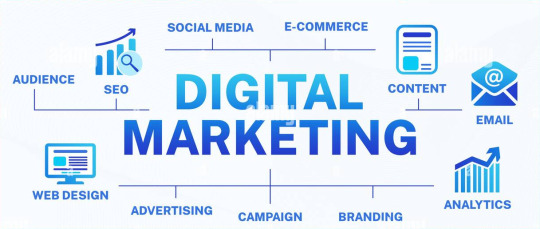
1. Assess the Current Landscape
Before diving into planning, analyze the existing trends, tools, and technologies shaping digital marketing. Key trends in 2025 include:
AI-Driven Marketing: Automation, chatbots, and predictive analytics are dominating marketing strategies.
Voice and Visual Search: Consumers are relying more on voice commands and image-based searches.
Personalization at Scale: Hyper-targeted campaigns fueled by AI and data analytics.
Video Marketing Growth: Short-form videos, live streams, and interactive videos remain highly engaging.
Sustainability and Ethics: Consumers prioritize businesses with ethical practices and sustainable approaches.
2. Set Clear Goals
Define what you want to achieve with your digital marketing efforts. Common goals include:
Increasing brand awareness.
Generating high-quality leads.
Boosting conversion rates.
Enhancing customer engagement.
Building thought leadership.
Use the SMART framework (Specific, Measurable, Achievable, Relevant, Time-bound) to ensure your goals are actionable.
3. Understand Your Audience
Consumer preferences evolve, and so should your understanding of your target audience. In 2025, leverage advanced tools such as:
AI-Powered Analytics: Tools like Google Analytics 4 and HubSpot provide detailed customer insights.
Social Listening Tools: Platforms like Brandwatch monitor trends and conversations.
Behavioral Segmentation: Group audiences based on browsing patterns, purchase history, and preferences.
Develop detailed buyer personas to tailor campaigns effectively.
4. Optimize for Emerging Technologies
Artificial Intelligence and Machine Learning
AI-driven marketing automation tools can optimize ad placements, personalize content, and improve user experiences.
Voice Search Optimization
Ensure your content is optimized for conversational keywords and question-based queries, as voice search becomes mainstream.
Augmented Reality (AR) and Virtual Reality (VR)
Incorporate AR and VR experiences for interactive ads and virtual product demonstrations.
Blockchain for Transparency
Blockchain technology ensures transparency in ad tracking, combating fraud and building trust with customers.

5. Create a Multi-Channel Strategy
Diversify your approach by integrating multiple channels:
Social Media Marketing: Prioritize platforms like TikTok, Instagram Reels, and LinkedIn.
Content Marketing: Develop blogs, e-books, and case studies to establish authority.
Email Marketing: Focus on personalized email sequences and automation.
Influencer Partnerships: Collaborate with niche influencers to expand reach.
SEO and SEM: Stay updated with search engine algorithms to maintain visibility.
6. Focus on Content Creation and Storytelling
Content remains king, but in 2025, the focus is on storytelling and value-driven content. Tips for effective content creation:
Use interactive formats such as quizzes, polls, and surveys.
Incorporate user-generated content to build authenticity.
Develop video-first strategies for platforms like YouTube and TikTok.
Optimize for micro-moments—short bursts of attention in mobile searches.
7. Invest in Data Analytics and Measurement Tools
Track performance and ROI with the latest tools:
Google Analytics 4 for predictive insights.
CRM platforms like Salesforce and HubSpot for sales tracking.
Heatmaps and session recordings to analyze user behavior.
A/B testing tools to optimize campaigns in real time.
8. Prioritize Privacy and Compliance
With evolving privacy laws like GDPR and CCPA, ensure your campaigns comply with regulations. Key practices include:
Using cookie-less tracking solutions.
Implementing data encryption and secure data storage.
Being transparent about data collection and usage.

9. Budget and Resource Allocation
Evaluate your marketing budget based on past performance and future goals. Allocate resources across channels effectively:
Paid Advertising: PPC, social ads, and retargeting campaigns.
Organic Growth: SEO, content marketing, and community building.
Tools and Software: Marketing automation and data analytics tools.
10. Test, Optimize, and Iterate
Digital marketing success depends on continuous testing and optimization. Follow these steps:
Conduct A/B tests for ads, emails, and landing pages.
Analyze key performance indicators (KPIs) regularly.
Gather feedback through surveys and customer reviews.
Adapt strategies based on real-time data and insights.
Digital marketing in 2025 is all about adaptability, personalization, and leveraging cutting-edge technologies. By setting clear goals, understanding your audience, embracing AI and data analytics, and staying compliant, you can create impactful campaigns that drive growth. Start planning today and position your brand for success in the ever-changing digital landscape.
To hire an expert visit : www.vortixai.co.uk
0 notes
Text
Voice Interfaces and UX: Designing for a Screenless Future
Technology is rapidly shifting towards a screenless, voice-first world. From smart speakers and virtual assistants to in-car systems and wearable devices, voice interfaces are transforming how users interact with technology. As designers, we must embrace this evolution and rethink the principles of user experience (UX) to craft intuitive, human-centered voice interactions.
In this blog, we’ll explore the rise of voice interfaces, key design principles, and strategies to create seamless voice-driven experiences.

The Rise of Voice Interfaces
Voice technology is no longer a futuristic concept—it’s a part of our daily lives. Devices like Amazon Alexa, Google Assistant, and Apple Siri have normalized voice interactions, and adoption rates continue to climb.
Key Statistics
Over 50% of searches are now voice-based.
The global voice assistant market is projected to reach $30 billion by 2026.
More than 35% of households own at least one smart speaker.
Voice interfaces are thriving because they:
Provide hands-free, faster interactions.
Offer accessibility for visually impaired or physically challenged users.
Integrate seamlessly into IoT ecosystems, from smart homes to connected cars.
Challenges in Designing Voice UX
While voice interfaces offer convenience, designing them poses unique challenges:
Lack of Visual Feedback Users can’t see menus, buttons, or progress bars, making it harder to understand system states.
Context Awareness Voice systems must handle ambiguity, accents, and varying speech patterns.
Error Handling Misunderstandings are common, so systems must gracefully handle errors without frustrating users.
Privacy Concerns Users are often skeptical about privacy and data security with always-listening devices.

Key Principles for Voice UX Design
1. Conversational Flow
Voice interfaces should feel natural and conversational.
Use simple, clear language.
Avoid jargon and complex sentences.
Provide prompts to guide users without overwhelming them.
Example: Instead of asking: “Would you like to hear today’s weather forecast or traffic updates?” Try: “Do you want to know the weather or traffic updates?”
2. Contextual Understanding
Design for context awareness. Voice assistants should:
Recognize user intent even with incomplete information.
Adapt responses based on previous interactions.
Example: User: “What’s the weather?” System: “Sure! Is this for your current location or somewhere else?”
3. Error Recovery
Mistakes happen. Good design anticipates errors and provides solutions.
Offer helpful suggestions rather than generic error messages.
Allow users to rephrase or repeat commands.
Example: Instead of saying: “I didn’t get that.” Say: “I didn’t catch that. Did you mean to check your calendar or reminders?”
4. Feedback and Confirmation
Without visual cues, voice interfaces must provide audio feedback.
Use tone and pacing to make responses sound human-like.
Confirm actions to avoid ambiguity.
Example: “Got it! I’ve added ‘buy groceries’ to your to-do list.”
5. Accessibility and Inclusivity
Voice interfaces must be inclusive.
Support multiple languages and accents.
Design for speech impairments by integrating customizable voice commands.
Ensure compatibility with screen readers for hybrid experiences.
Designing for Multimodal Experiences
While voice is powerful, blending it with visual or tactile feedback enhances usability. Many devices, like Echo Show and Google Nest Hub, combine voice and screens for richer interactions.
Key Strategies:
Provide visual reinforcements like subtitles or progress indicators.
Use hybrid input options (e.g., voice and touch).
Design workflows that let users switch between voice and screen effortlessly.
Testing Voice Interfaces
Designing for voice requires rigorous testing to ensure usability.
Best Practices for Testing:
Simulate Real Scenarios: Test in noisy environments to assess speech recognition accuracy.
Conduct User Testing: Observe how users interact with the system to identify friction points.
Analyze Logs: Use conversation logs to track errors and improve performance.
The Future of Voice UX
Voice interfaces are evolving with AI and machine learning advancements. Key trends to watch include:
Emotion Recognition: Systems that adapt tone and responses based on user mood.
Voice Biometrics: Enhanced security using voice authentication.
AI-driven Context Awareness: Smarter assistants that anticipate needs without prompts.
Integration with AR/VR: Voice commands as a primary input method for immersive environments.
Conclusion: Designing for Tomorrow
Voice interfaces represent the next frontier in UX design. As we move toward a screenless future, creating intuitive, responsive, and accessible voice-driven experiences will be critical.
At VortixAI, we specialize in designing cutting-edge voice interfaces that redefine user interactions. Ready to make your product voice-ready? Contact us today and let’s create the future of UX together!
0 notes
Text
Top 5 AI Tools Revolutionizing Digital Marketing in 2025

In the rapidly evolving landscape of digital marketing, staying ahead requires leveraging cutting-edge tools that deliver results with precision and efficiency. As we step into 2025, artificial intelligence (AI) continues to dominate the industry, providing marketers with the power to automate, analyze, and optimize like never before. Here are the top five AI tools that are transforming digital marketing this year:
1. ChatGPT for Content Creation and Personalization
OpenAI’s ChatGPT has grown into a must-have tool for marketers in 2025. The latest iterations are capable of creating high-quality, personalized content at scale, from blog posts and social media captions to email campaigns. Its ability to analyze user behavior and tailor messages based on audience preferences ensures that brands deliver hyper-relevant experiences, boosting engagement and conversions.
Key Features:
Advanced natural language processing (NLP) for context-aware content.
Real-time updates for personalized messaging.
Integration with popular CMS and CRM tools.
Use Case: A retail brand uses ChatGPT to draft personalized emails recommending products based on individual browsing history and purchase behavior.
2. MarketMuse for SEO and Content Optimization
SEO remains a cornerstone of digital marketing, and MarketMuse is leading the charge in 2025. This AI-powered tool helps marketers craft content that ranks higher on search engines by analyzing existing pages, identifying content gaps, and recommending improvements.
Key Features:
Comprehensive keyword research and clustering.
Content scoring based on SEO best practices.
Competitor analysis to find ranking opportunities.
Use Case: A SaaS company uses MarketMuse to optimize its blog posts, ensuring they align with high-ranking keywords and address gaps in competitor content.
3. Adzooma for PPC Campaign Automation
Managing pay-per-click (PPC) campaigns has never been easier, thanks to Adzooma. This AI-driven platform simplifies campaign management across Google, Facebook, and Microsoft Ads. Its advanced algorithms automatically optimize bids, budgets, and targeting to maximize ROI.
Key Features:
Automated performance monitoring and recommendations.
Multi-platform campaign management in one dashboard.
AI insights to reduce ad spend waste.
Use Case: A small business leverages Adzooma to automate its ad campaigns, achieving higher click-through rates while reducing costs.
4. HubSpot AI for Customer Relationship Management (CRM)
HubSpot’s AI tools have revolutionized CRM in 2025 by streamlining lead nurturing and customer interaction. From AI-driven chatbots to predictive analytics, HubSpot ensures marketers can deliver the right message at the right time to the right audience.
Key Features:
AI chatbots for instant customer support and lead qualification.
Predictive lead scoring to identify high-value prospects.
Automated workflows for personalized email sequences.
Use Case: An e-commerce platform uses HubSpot AI to send tailored product recommendations to customers based on their previous interactions, driving repeat purchases.
5. Synthesia for Video Marketing
Video continues to dominate as a preferred content format, and Synthesia’s AI video creation platform is a game-changer. Marketers can create professional-quality videos without needing a camera crew or studio. Synthesia’s AI avatars and voiceovers allow for quick and scalable production of explainer videos, ads, and tutorials.
Key Features:
AI-generated avatars and natural-sounding voiceovers.
Multilingual video production for global audiences.
Customizable templates for various industries.
Use Case: A global brand uses Synthesia to create product tutorials in multiple languages, ensuring accessibility across diverse markets.
As we navigate the competitive digital landscape of 2025, these AI tools stand out as indispensable assets for marketers. Whether it’s creating engaging content, optimizing campaigns, or delivering personalized experiences, AI continues to push the boundaries of what’s possible in digital marketing. By integrating these tools into your strategy, you’ll be better equipped to connect with your audience and achieve your business goals.
For Expert Advice on how you can use them in your Business connect with us www.vortixai.co.uk
0 notes
Text
Digital Marketing in 2025: Trends, Innovations, and Strategies
Digital marketing is evolving at breakneck speed, and 2025 promises to be a transformative year. With rapid advancements in AI, increasing concerns about data privacy, and the rise of immersive technologies, businesses must adapt to stay relevant. Here’s a glimpse into the future of digital marketing in 2025.
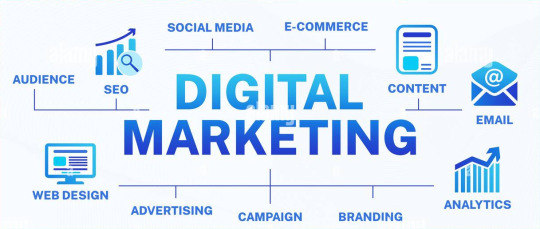
1. AI-Driven Marketing Takes Center Stage
Artificial intelligence (AI) is now at the core of digital marketing, enabling hyper-personalization and predictive analytics. In 2025, AI will:
Craft highly customized content for individual consumers.
Automate customer interactions via advanced chatbots and virtual assistants.
Optimize ad spend by predicting the most effective platforms, times, and audiences.
AI tools will also generate real-time insights, allowing marketers to tweak campaigns on the fly and maximize ROI

2. Immersive Experiences with AR and VR
Augmented reality (AR) and virtual reality (VR) will redefine customer engagement:
AR Shopping Experiences: Customers can try products virtually, from clothing to furniture, before purchasing.
VR Events and Product Launches: Brands can host immersive events, creating unique virtual spaces for customers to explore.
This trend will particularly impact industries like retail, real estate, and entertainment
3. Voice and Visual Search on the Rise
Search behavior is shifting dramatically:
Voice Search: With smart devices becoming ubiquitous, voice commands are dominating search queries. Marketers must optimize content for natural language and conversational keywords.
Visual Search: Platforms like Pinterest Lens and Google Lens enable users to search with images. Brands will need to focus on high-quality visuals and metadata optimization to stay competitive
https://vortixai.co.uk/digital-marketing-in-2025-trends-innovations-and-strategies/
4. Sustainability in Marketing
Consumers are increasingly prioritizing eco-friendly brands. In 2025:
Digital campaigns will emphasize sustainability, highlighting brands’ green initiatives.
Packaging, messaging, and even digital assets will reflect eco-conscious values. Marketers will need to ensure authenticity, as greenwashing can lead to backlash
5. The Role of Privacy in Marketing
With stricter data privacy regulations worldwide, transparency is key. Marketers will:
Shift towards first-party data strategies, relying on direct customer interactions for insights.
Use privacy-focused tools and platforms to build trust.
Develop creative, consent-based methods to collect user data

6. Influencer Marketing Matures
In 2025, influencer marketing will become more authentic and niche:
Micro and Nano-Influencers: Smaller influencers with highly engaged audiences will outperform celebrities in many sectors.
AI-Generated Influencers: Virtual personalities and avatars will represent brands in innovative ways
7. The Rise of Predictive Marketing
Predictive analytics will empower brands to anticipate customer needs:
Campaigns will be designed based on future behavior predictions, offering preemptive solutions to customer problems.
AI algorithms will analyze data trends to create targeted offers
8. Focus on Community Building
Digital marketing in 2025 will emphasize meaningful engagement:
Brands will invest in creating loyal online communities.
Platforms like Discord and Slack will host branded groups, fostering direct interactions with audiences

Adapting to the Future
The digital marketing landscape in 2025 will be driven by technology, ethics, and a deep understanding of customer behavior. Marketers must remain agile, embrace innovation, and maintain authenticity to thrive in this ever-evolving ecosystem.
As the boundaries between the digital and physical worlds blur, the question remains: how will your brand adapt to shape the future of marketing?
Connect with AI Marketing Expert at VortixAI and Grow your business to new heights in 2025 !!!
0 notes
Text
How to Start a Career in AI or Machine Learning

The rise of artificial intelligence (AI) and machine learning (ML) has brought about a revolution in various industries, from healthcare and finance to entertainment and transportation. AI is increasingly seen as the future, with applications ranging from self-driving cars to personal assistants. As a result, many are looking to transition into this booming field. But how exactly can you begin your career in AI or machine learning?
Starting a career in AI or ML requires a blend of technical skills, continuous learning, and passion for problem-solving. Whether you’re a beginner or looking to enhance your existing knowledge, this blog will guide you through the steps needed to break into the world of AI and machine learning.
To Read the complete article visit our blog at : https://vortixai.co.uk/how-to-start-a-career-in-ai-or-machine-learning/
0 notes
Text
Use of AI in UI/UX design 2025

AI is increasingly playing a transformative role in UI/UX design, helping designers to create more intuitive, personalized, and efficient user experiences. Here are several ways in which AI is being applied in this field:
1. Personalization and Customization
AI can analyze user behavior, preferences, and interactions to dynamically personalize interfaces. By tracking user patterns, AI can tailor UI elements, content, and layout to meet individual needs, providing a more engaging and relevant experience. For example:
Adaptive Content: AI can serve content based on user interests, location, and past behavior.
Personalized Recommendations: In e-commerce or media apps, AI can suggest products, articles, or videos based on a user’s activity.
2. Automated Design Generation
AI tools can assist designers by automating certain aspects of the design process:
Layout Generation: AI can suggest layout options based on the content type and structure. Tools like Figma and Adobe Sensei have begun integrating AI-powered features to automate repetitive tasks, saving designers time.
Logo and Color Palette Creation: AI tools can generate logos, color schemes, and typography options based on brand guidelines, allowing for rapid prototyping.
3. User Behavior Analysis and Insights
AI can analyze vast amounts of user data and provide valuable insights into how users interact with a product. By identifying patterns, AI helps designers make data-driven decisions to improve the user experience:
Heatmaps and Click Tracking: AI-driven tools like Hotjar or Crazy Egg analyze user interaction on websites, offering heatmaps that highlight where users click, scroll, and hover the most. This helps in optimizing UI placement and design.
Predictive Analytics: AI can predict user behavior, such as when a user might abandon a cart or when they’re most likely to engage with certain elements of a website.
4. Improved Usability Testing
AI tools help streamline usability testing by offering automated solutions to assess the effectiveness of a design:
AI Usability Testing Platforms: Tools like PlaybookUX and Maze leverage AI to conduct usability tests by analyzing user interactions, behavior, and feedback to highlight areas for improvement.
Session Replay & Emotion Recognition: AI can analyze recorded user sessions and detect facial expressions or sentiment, helping designers understand users’ emotional reactions to different UI elements.
To Read More : Click Below
Or Visit our Website Blog at : www.vortixai.co.uk/blog
0 notes
Text
Unlock the Potential of AI-Driven Marketing with VORTIX AI
1 note
·
View note